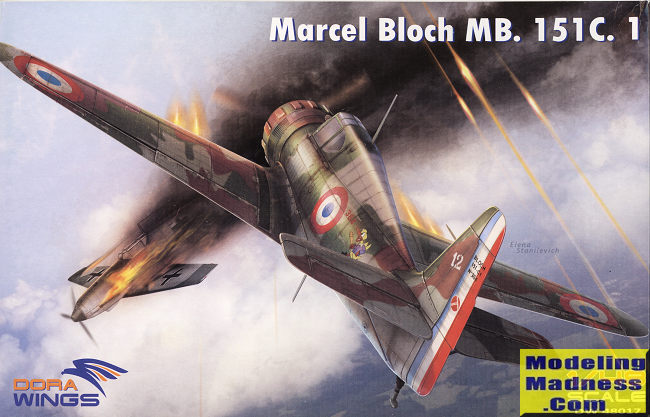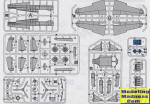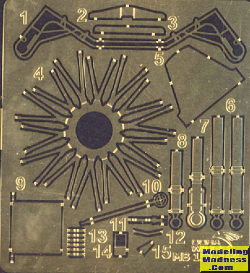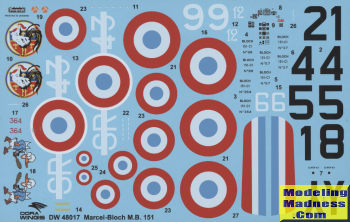
| KIT #: | 48017 |
| PRICE: | $18.00 |
| DECALS: | Four options |
| REVIEWER: | Scott Van Aken |
| NOTES: | Short run |

| HISTORY |
The Bloch MB.150 (later MB.151 to MB.157) was a French low-wing monoplane fighter aircraft developed and produced by Société des Avions Marcel Bloch. It featured all-metal construction, complete with a retractable undercarriage and a fully enclosed cockpit. Despite losing the fighter competition to the MS.406, it was decided to put the aircraft into production .
There was no direct production of the MB-150.01 as the aircraft having been deemed to be unsuitable for mass production. Amongst other changes needed, the structure of the airframe had to be redesigned in order to suit mass production. During early April 1938, an order was received for a three further prototypes; these were to explore the possibilities for installing more powerful engines of both French and American origins, such as the Hispano-Suiza 14AA, Pratt & Whitney R-1830 Twin Wasp, and further derivatives of the Gnome-Rhône 14N engine. Accordingly, this design effort led to the production of the MB.151.01 and MB.152.01 prototypes, which were developed and produced in parallel.
The first pre-production prototype, the MB.151.01, was quickly assembled at Courbevoie using the new simplified construction methods developed. This aircraft, which was fully armed, performed its first flight at Villacoublay Airfield, Île-de-France, on 18 August 1938. According to Christesco, the performance of the MB.151.01 was initially disappointing, leading to efforts to rectify performance issues. Development, and thus mass production, was delayed by the overheating of the engine (resulting in oil cooler types being tested and the most efficient of these adopted) and the aircraft being poorly balanced on its pitch axis at high speeds; neither the prototype nor the production MB.151 were able to attain 480 km/h, the design's estimated maximum speed.
According to Christesco, the MB.152.01 was "the first true aircraft" of the series. This model was equipped with a more powerful 1,030 hp Gnome-Rhône 14N-21 engine, capable of a speed of 520 km/h and equipped with a revised armament arrangement. On 15 December 1938, the MB.152.01 prototype performed its maiden flight. During January 1939, it was refitted with a more production-representative 1,000 hp Gnome-Rhône 14N-25 engine; various alternative engine cowlings and propellers were also tested to address engine overheating. To prevent further delays to the production aircraft, a large cowling was adopted, which increased drag and reduced the MB.152's flight performance.
The manufacturing of the fighter was divided amongst the various branches comprising SNCASO. Aside from a handful that were assembled at Courbevoie early on, roughly half of all aircraft produced were manufactured at Chateauroux, Berry while the other half were built at Bordeaux–Merignac, Nouvelle-Aquitaine. From January 1940 onwards, production was centered at Chateauroux alone. During December 1938, the first of the pre-production aircraft were completed; on 7 March 1939, the first production fighter was delivered to the French Air Force. By mid-May 1939, only 22 aircraft, a combination of MB.151s and MB.152s, had been dispatched; of these, only 10 had been accepted by the Air Force.
This inability of French industry to provide complete aircraft plagued all other aspects of French production and was never successfully cured. At the beginning of the war, only 249 planes had been manufactured and about 123 had been accepted by the French Air Force. Of that number most were not flyable, missing propellers or gun sights. In combat the planes were wholly outclassed by the Bf-109E and were slower than the Bf-110. Eventually over 600 were built, but to say the type was a disappointment would be a bit of an understatement.
| THE KIT |
 Despite
the fact that the
Despite
the fact that the aircraft was pretty much a total failure, it was still an important fighter
used during the early part of WWII and certainly looks as if it should have
been effective. There have not been all that many kits done of this with all
but the 1/72 Heller kit being either resin or like this one, a short run
kit. In 1/48, this one is preceded by several variants done by Classic
Airframes.
aircraft was pretty much a total failure, it was still an important fighter
used during the early part of WWII and certainly looks as if it should have
been effective. There have not been all that many kits done of this with all
but the 1/72 Heller kit being either resin or like this one, a short run
kit. In 1/48, this one is preceded by several variants done by Classic
Airframes.  The kit
itself comes on a number of smallish sprues with the parts all having a fair
number of sprue attachment points. For instance, each fuselage half has 13
of these. Otherwise the parts have nice external detail. A photo etch fret
is included for things like a seat harness, engine pushrods, the pilot's
seat, rudder trim tab, head armor, gun sight and a few other bits. There is
interior sidewall detail and various boxes to attach to them and the cockpit
floor.
The kit
itself comes on a number of smallish sprues with the parts all having a fair
number of sprue attachment points. For instance, each fuselage half has 13
of these. Otherwise the parts have nice external detail. A photo etch fret
is included for things like a seat harness, engine pushrods, the pilot's
seat, rudder trim tab, head armor, gun sight and a few other bits. There is
interior sidewall detail and various boxes to attach to them and the cockpit
floor.  cooler
intake and tail skid finishes up the airframe. A diagram is provided to
ensure that you get the proper off-set of the engine.
cooler
intake and tail skid finishes up the airframe. A diagram is provided to
ensure that you get the proper off-set of the engine. | CONCLUSIONS |
Dora Wings kits have gotten some good press from some over the recent months, but keep in mind, these are still short run kits and even those who have liked them have admitted that you need the appropriate modeling skills and some patience to build them. Is this better than the Classic Airframes kit of 20 years ago? Probably as even the short run genre has seen a lot of improvement over time. Of course the proof is in the building. If you missed the CA kit and want a Block 150 series, then this would be a good choice.
| REFERENCES |
https://en.wikipedia.org/wiki/Bloch_MB.150
September 2020
Copyright Modeling Madness.com.
If you would like your product reviewed fairly and fairly quickly, please contact the editor or see other details in the Note to Contributors.
Back to the Main Page Back to the Review Index Page Back to the Previews Index Page